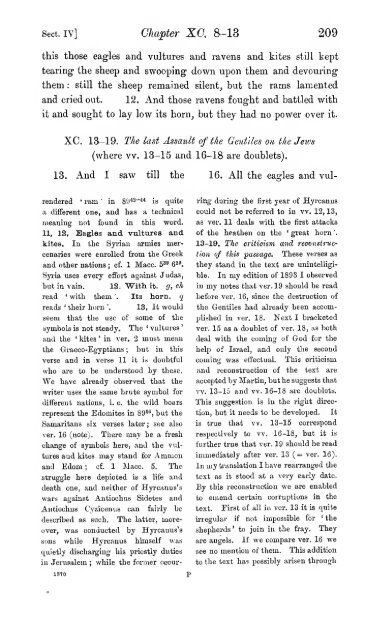the-book-of-enoch-r-h-charles - Fallen Angels
the-book-of-enoch-r-h-charles - Fallen Angels
the-book-of-enoch-r-h-charles - Fallen Angels
Create successful ePaper yourself
Turn your PDF publications into a flip-book with our unique Google optimized e-Paper software.
Sect. IV] Chapter XO. 8-13 209<br />
this those eagles and vultures and ravens and kites still kept<br />
tearing <strong>the</strong> sheep and swooping down upon <strong>the</strong>m and devouring<br />
<strong>the</strong>m :<br />
still <strong>the</strong> sheep remained silent, but <strong>the</strong> rams lamented<br />
and cried out. 12. And those ravens fought and battled with<br />
it and sought to lay low its horn, but <strong>the</strong>y had no power over it.<br />
XC. 13-19. IVte last Assault <strong>of</strong> <strong>the</strong> Gentiles on <strong>the</strong> Jews<br />
(where vv. 13-15 and 16-18 are doublets).<br />
13. And I saw till <strong>the</strong> 16. All <strong>the</strong> eagles and vul-<br />
rendered ' ram '<br />
in 89'"'-" is quite<br />
a different one, and has a technioal<br />
meaning not found in this word.<br />
11, 12, Eagles and vultures and<br />
kites. In <strong>the</strong> Syrian armies mer-<br />
cenaries were enrolled from <strong>the</strong> Greek<br />
and o<strong>the</strong>r nations ; <strong>of</strong>. 1 Mace. 5'' ei"'.<br />
Syria uses every effort against Judas,<br />
but in vain. 12. With it. g,elh<br />
read ' with <strong>the</strong>m '. Its horn. ^<br />
reads ' <strong>the</strong>ir horn '. 13, It would<br />
seem that <strong>the</strong> use <strong>of</strong> some <strong>of</strong> <strong>the</strong><br />
symbols is not steady. The ' vultures<br />
and <strong>the</strong> ' kites ' in ver. 2 must mean<br />
tlie Graeco-Eg'yptians ; but in this<br />
verse and in verse 11 it is doubtful<br />
who are to be understood by <strong>the</strong>se.<br />
We have already observed that <strong>the</strong><br />
writer uses <strong>the</strong> same brute symbol for<br />
different nations, i. e. <strong>the</strong> wild boars<br />
represent <strong>the</strong> Edomites in 89*'', but <strong>the</strong><br />
Samaritans six verses later; see also<br />
ver. 16 (note). There may be a fresh<br />
change <strong>of</strong> symbols here, and <strong>the</strong> vultures<br />
and kites may stand for Amnion<br />
and Edom ; cf. 1 Jlaco. 5. The<br />
struggle here depicted is a life and<br />
death one, and nei<strong>the</strong>r <strong>of</strong> Hyrcanus's<br />
wars against Antiochus Sidetes and<br />
Antiochus Cyzioenus can fairly be<br />
described as such. The latter, more-<br />
over, was conducted by Hyrcanus's<br />
suns while Hyrcanus himself was<br />
quietly discharging his priestly duties<br />
in Jerusalem ;<br />
while <strong>the</strong> former ocour-<br />
1370 p<br />
'<br />
ring during <strong>the</strong> first year <strong>of</strong> Hyrcanus<br />
could not be referred to in vv. 12, 13,<br />
as ver. 11 deals with <strong>the</strong> first attacks<br />
<strong>of</strong> <strong>the</strong> hea<strong>the</strong>n on <strong>the</strong> ' great horn '.<br />
13-19, The criticism and reconstruc-<br />
tion <strong>of</strong> this passage. These verses as<br />
<strong>the</strong>y stand in <strong>the</strong> text are unintelligi-<br />
ble. In my edition <strong>of</strong> 1893 I observed<br />
in my notes that ver. 19 should be read<br />
before ver. 16, since <strong>the</strong> destruction <strong>of</strong><br />
<strong>the</strong> Gentiles had already been accom-<br />
plished in ver. 18. Next I bracketed<br />
ver. 15 aa a doublet <strong>of</strong> ver. 18, as both<br />
deal with <strong>the</strong> coming <strong>of</strong> God for <strong>the</strong><br />
help <strong>of</strong> Israel, and only <strong>the</strong> second<br />
coming was effectual. This criticism<br />
and reconstruction <strong>of</strong> <strong>the</strong> text are<br />
accepted by Martin, but he suggests that<br />
vv. 13-15 and vv. 16-18 are doublets.<br />
This suggestion is in <strong>the</strong> right direc-<br />
tion, but it needs to be developed. It<br />
is true that vv. 13-15 correspond<br />
respectively to vv. 16-18, but it is<br />
fur<strong>the</strong>r true that ver. 19 should be read<br />
immediately after ver. 13 (== ver. 16).<br />
In my translation I have rearranged <strong>the</strong><br />
text as it stood at a very early date.<br />
By this reconstruction we are enabled<br />
to emend certain corruptions in <strong>the</strong><br />
text. First <strong>of</strong> all in ver. 13 it is quite<br />
iri'egular if not impossible for ' <strong>the</strong><br />
shepherds' to join in <strong>the</strong> fray. They<br />
are angels. If we compare ver. 16 we<br />
see no mention <strong>of</strong> <strong>the</strong>m. This addition<br />
to <strong>the</strong> text has possibly arisen through


